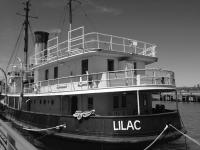 In her long and varied career, the historic cutter Lilac has had many jobs. She served as a lighthouse and buoy tender — bringing supplies to lighthouse and maintaining aids to navigation. She also fought ship fires and rescued the keepers on endangered offshore lighthouses. During World War II, she was armed with guns and depth charge, but never fired a shot in combat.
In her long and varied career, the historic cutter Lilac has had many jobs. She served as a lighthouse and buoy tender — bringing supplies to lighthouse and maintaining aids to navigation. She also fought ship fires and rescued the keepers on endangered offshore lighthouses. During World War II, she was armed with guns and depth charge, but never fired a shot in combat.
Yesterday, Lilac took on a more unusual role, as a star in a saucy television commercial. Specifically, she was towed to the Caddell Dry Dock and Repair in Staten Island for the afternoon to appear in a commercial celebrating the 1937 arrival of the Italian immigrants. Following the shoot, the Lilac was towed back to her berth at Pier 25 on the Manhattan side of the Hudson river.
While this may be the first commercial that has featured the Lilac on Staten Island, the Lilac is no stranger to the island, although this is her visit in over four decades. As the U.S. Lighthouse Tender Lilac, she called at the U.S. Lighthouse Service Depot in St. George, Staten Island. Assigned to the Fourth Lighthouse District, Lilac carried supplies to lighthouses and maintained buoys and other aids to navigation on the Delaware River from Trenton, NJ south to Lewes, DE. When the ship needed maintenance or upgrades to equipment, she went to the Staten Island Depot at St. George. Later, as lighthouses became automated, maintenance of local tenders was moved to the Coast Guard’s shipyard in Curtis Bay, MD and the depot on Staten Island was closed. Building 11, once the machine shop of the Staten Island Lighthouse Service Depot, is now the home of the National Lighthouse Museum.
Lilac is a 1933 lighthouse tender for the U.S. Lighthouse Service and the U.S. Coast Guard. Decommissioned in 1972, USCGLilac is now a museum ship owned by the non-profit Lilac Preservation Project. As America’s only surviving steam-powered lighthouse tender, Lilac is listed on the National Register of Historic Places and is eligible to become a National Historic Landmark.

There is nothing like triple expansion steam.
I graduated from Cal Poly in California in 1965 as a mechanical engineer and volunteered for USCG OCS in Yorktown, Virginia.
Affectionately refered to as the “LIL” by the crew, as a Reserve LTJG I sailed on her as a guest of Capt Purdy in 1968. I was checking out channel range performance characteristics on the Delaware. It was quite amazing.
On the best designed most sensitive range, which I had checked by light list beforehand, I could distinquish lateral movement by simply walking the foward deck (buoy deck) from starboad to port. I had designed a computer program at USCG HQ to optimize range performance given physical design limitations. My boss at HQ: LCDR Walt White presented my results at an international lighthouse conference.
My best memory was when we moored at New Castle, Delaware and the crew took a swim and many children came down to the Park/Landing for a baseball game with the crew. A wonderful time it was and after mess we all got in dress uniform and in best behavior we all visited a pub just up the street.
It was the best of times.
I was 26 years of age.
Russ Taylor